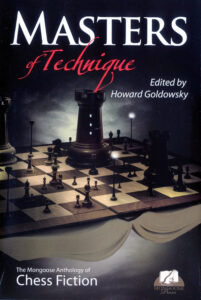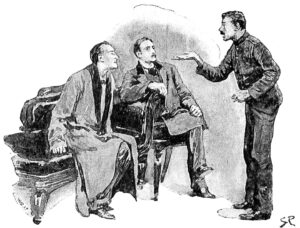Leslie Klinger on Sherlock Holmes
 As a sort of coda to publication of my Sherlock Holmes story, “The Adventure of the Black Bishop,” available on Amazon as a stand-alone or in the chess fiction anthology Masters of Technique, here is an interview I did with Sherlock Holmes expert, Leslie S. Klinger, around the time of the story’s publication.
As a sort of coda to publication of my Sherlock Holmes story, “The Adventure of the Black Bishop,” available on Amazon as a stand-alone or in the chess fiction anthology Masters of Technique, here is an interview I did with Sherlock Holmes expert, Leslie S. Klinger, around the time of the story’s publication.
Leslie is considered to be one of the world’s foremost authorities on Sherlock Holmes. He is the editor of the three-volume set The New Annotated Sherlock Holmes, published by W.W. Norton in 2004 and 2005. The first two volumes, The Complete Short Stories, won the Edgar™, the highest award of the Mystery Writers of America, for “Best Critical/Biographical” work in 2005 and were short-listed for every other major mystery award. The third volume, The Novels was nominated for an Edgar™ and a Quill™ award as well as every other major mystery award.
Mark Coggins: What is a “Sherlockian” and what is “the game” they play?
Leslie Klinger: “Sherlockians” (known, for unknown reasons, as “Holmesians” in the UK) are people dedicated to keeping green the memory of the Master, through study, scholarly writing, teaching, and other celebrations. Most Sherlockians indulge in what has become known as “the game”: the gentle fiction that Sherlock Holmes and John H. Watson really lived and that the stories of the Canon (the 56 short stories and 4 novels) published under the name of Arthur Conan Doyle are true accounts of the lives of Holmes and Watson, largely written by Dr. Watson himself and published on his behalf by his friend and “literary agent” Conan Doyle.
MC: You had a chance to review my story and gave me some great suggestions on how to correct things that were inconsistent with either the Holmes Canon or life in Victorian England. One of the most interesting ones was a reference I have Watson make to The Hound of the Baskervilles. What was your concern about that?
LK: My concern had to do with the dates of the events in your story and the dates of the events described in The Hound of the Baskervilles. Most scholars place The Hound of the Baskervilles no earlier than October 1889 (except for the eccentric dating by William Baring-Gould, who puts it in October 1888) and many as late as 1899 or 1900 (of course, it was not published until 1901). Even if the events of The Hound began in October 1888, I find it hard to believe that Watson would be placing his “finishing touches” on this long story in January, when the events only concluded at the end of November. And where is Mary Morstan Watson? By January 1889, there is good reason to believe that Watson would be married.
MC: What is the controversy concerning Watson and his wife or wives?
LK: There are several references to Watson’s wife in the Canon, spread out over a long period of time. The principal concern revolves around Watson’s “sad bereavement” that occurred during Holmes’s absence from 1891 to 1894. Most scholars believe that this bereavement was the death of Mary Morstan Watson, for she is never again mentioned by name. Yet Watson mentions a wife after 1900, and Holmes remarks that Watson had left him “for a wife.” Was this a new wife? Someone else’s wife? The controversy continues unresolved.
MC: How many do you believe he had and how did you reach your conclusion?
LK: I believe that Watson had two wives, Mary Morstan Watson and an unnamed successor. I think the “bereavement” likely to have been the death of Mary (or perhaps her incarceration for madness, followed by her death years later). The later reference to Watson’s wife must be to a new one.
MC: In my story, I have Watson assert that Holmes has no previous experience of chess. Are there in fact references to the game in the original works?
LK: There are several offhand references to chess, but none that indicate that Holmes himself played it. I too, for example, might use a chess metaphor (e.g, “checkmating” someone) but I have virtually no experience of playing. In the story “The Retired Colourman,” Holmes does make the remark, “Amberley excelled at chess—one mark, Watson, of a scheming mind.”
MC: What are some of the other inconsistencies in the stories that Sherlockians try to reconcile?
LK: The location of Dr. Watson’s wound is the most famous—it appears to be in his shoulder in some stories but in his leg in others. Another example is the identity of the snake in the story “The Speckled Band.” There are many species that exemplify some of the characteristics described in the story but none that fit all.

MC: Are there references in the stories that still remain unexplained despite all the Holmes research? If so, which are your favorites and do you have any pet theories for their explanation?
LK: The most tantalizing mystery is the nature of Holmes’s activities during the period from 1891 to 1894, while he was absent from London following the confrontation with Professor Moriarty at the Reichenbach Falls. Holmes offers a brief explanation of his whereabouts, but many (including I) find it unconvincing. Where did he really go, and why? Did Moriarty really perish at the Reichenbach Falls? It seems unlikely that the aging professor would have fomented a physical confrontation with the more physical Holmes. Did they reach some pact of mutual, secret co-existence? Did Mycroft Holmes—at times he “was” the British government—play a role in arranging this détente? We may never know.
MC: What sort of research did you personally do to prepare the annotated volumes? Did you have any interesting or surprising experiences during the research?
LK: I read extensively in preparation for the annotations. I have a vast library of materials—over 4,000 books on Holmes, Doyle, and the Victorian era—and I tried to encompass everything in my annotations. Obviously I failed, but it was an amazing experience. One of the most interesting experiences during the course of the research was the discovery of the great wealth of 19th-century material now available—in full text—on the Internet. It was often astonishing to use Google to search for materials on some obscure point, only to find it leading me to a book already on my own bookshelves! I also benefitted greatly from the resources of libraries, which notwithstanding the Internet, still form the backbone of research. Kudos in particular to the amazing collection at the University of Minnesota Anderson Library, the world’s largest collection of Sherlockian material, and the wonderful staff and volunteers there who helped me fill in those gaps on my bookshelves.
MC: I understand you often consult on Sherlock Holmes literary and cinematic projects and that you helped Robert Downey Jr. prepare for the lead role in the recent Holmes movie. Can you tell us a little bit about what you did and how it was to work with him?
LK: Robert Downey, Jr., and I met through a mutual friend who knew of my passion for Holmes and the new film. RDj came over to my home, where I was able to show and loan him a number of books about Holmes, and we spent hours talking about Holmes’s motivations. In particular, RDj was particularly interested in discussing why Holmes was so driven to pursue justice. We talked about the ideas of various scholars, but I think that over the course of the films, we will learn RDj’s own ideas about what made him tick.
MC: Can you talk a little about the history of pastiches like mine?
LK: Stories in the style of Arthur Conan Doyle and about Sherlock Holmes have appeared almost continuously since 1894, when Doyle first took a break from writing them. Some are serious (termed “pastiches”), some deliberately funny (called “parodies”). Some use Holmes and Watson to pursue specific agenda (e.g., “Sherlock Holmes in Dallas,” a serious book about the Kennedy assassination narrated by Holmes). The great writer Nicholas Meyer, author of The Seven Per-Cent Solution, one of the most celebrated pastiches ever written, explained the urge to write pastiche as testing oneself against the gold standard. Having written one, and only one, in my career, for me, it satisfied the desire for “more”—more stories about my favorite subject of stories.

MC: Do you have a favorite story or novel from the original Canon?
My favorite story is “The Blue Carbuncle,” a perfect story for the holiday season, with an unusual crime, a fascinating series of deductions and a twisting trail, combined with a detailed portrait of the warm friendship between Holmes and Watson. In the end, it is a story of forgiveness, what Christopher Morley termed “a Christmas story without slush.”
MC: If Doyle were alive today, what question would you ask him?
LK: “Do you now see the value of the Sherlock Holmes stories, whose worth you so deprecated during your life?”
